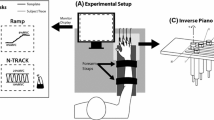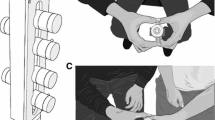Abstract
Humans are known to show anticipatory adjustments in the grip force prior to a self-generated or predictable action or perturbation applied to a hand-held object. We investigated whether humans can also adjust covariation of individual finger forces (multi-finger synergies) prior to self-triggered perturbations. To address this issue, we studied adjustments in multi-digit synergies associated with applied load/torque perturbations while the subjects held a customized handle steadily. The main hypothesis was that the subjects would be able to demonstrate the phenomenon of anticipatory covariation, that is changes in covariation patterns among digit forces and moments of force in anticipation of a perturbation, but only when the perturbation was triggered by the subjects themselves. Based on the principle of superposition (decoupled grasping force and resultant torque control), we also expected to see different adjustments in indices of multi-digit synergies stabilizing the total gripping force and the total moment of force. The task for the subjects (n = 8) was to return the initial handle position as quickly as possible after a perturbation, which consisted of removing one of three loads hanging from the handle. There were six experimental conditions: two types of perturbations (self-triggered and experimenter-triggered) by three positions of the load (left, center, and right). Three-dimensional forces and moments of force recorded from each digit contact were used for the analysis. Indices of covariation among digit forces and among moments of force, previously employed for studying motor synergies, were computed across trials. Positive values of the indices reflected negative covariations of individual digit forces and moments of force (their inter-compensatory changes) to stabilize the total force and moment acting on the handle. In steady-state conditions, subjects showed strong positive indices for both digit forces and digit moments. Under the self-triggered conditions, changes in the indices of digit force and moment covariation were seen about 150 ms prior to the perturbation, while such changes were observed only after the perturbation under the experimenter-triggered conditions. Immediately following a perturbation, the indices of force and moment covariation rapidly changed to negative revealing the lack of inter-compensation among the individual digit forces and moments. Later, both indices showed a recovery to positive values; the recovery was faster in the self-triggered conditions than in the experimenter-triggered ones. During the steady-state phase after the perturbation, the indices of force and moment covariation decreased and increased, respectively, as compared to their values during the steady-state phase prior to the perturbation. We conclude that humans are able to adjust multi-digit synergies involved in prehensile tasks in anticipation of a self-triggered perturbation. These conclusions speak against hypotheses on the organization of multi-element actions based on optimal control principles. Different changes in the indices of force and moment covariation after a perturbation corroborate the principle of superposition. We discuss relations of anticipatory covariation to anticipatory postural adjustments.









Similar content being viewed by others
References
Adkin AL, Frank JS, Carpenter MG, Peysar GW (2002) Fear of falling modifies anticipatory postural control. Exp Brain Res 143:160–170
Arimoto S, Nguyen PTA (2001) Principle of superposition for realising dexterous pinching motions of a pair of robot fingers with soft-tips. IEICE Trans Fundam Electron Commun Comput Sci E84A:39–47
Arimoto S, Nguyen PTA, Han HY, Doulgeri Z (2000) Dynamics and control of a set of dual fingers with soft tips. Robotica 18:71–80
Arimoto S, Tahara K, Yamaguchi M, Nguyen PTA, Han HY (2001) Principles of superposition for controlling pinch motions by means of robot fingers with soft tips. Robotica 19:21–28
Aruin AS, Latash ML (1996) Anticipatory postural adjustments during self-initiated perturbations of different magnitude triggered by a standard motor action. Electroencephalogr Clin Neurophysiol 101:497–503
Aruin AS, Forrest WR, Latash ML (1998) Anticipatory postural adjustments in conditions of postural instability. Electroencephalogr Clin Neurophysiol 109:350–359
Belen’kiii VY, Gurfinkel VS, Pal’tsev YI (1967) Elements of control of voluntary movements. Biofizika 10:135–141
Danion F, Schoner G, Latash ML, Li S, Scholz JP, Zatsiorsky VM (2003) A mode hypothesis for finger interaction during multi-finger force-production tasks. Biol Cybern 88:91–98
Elble RJ, Leffler K (2000) Pushing and pulling with the upper extremities while standing: the effects of mild Alzheimer dementia and Parkinson’s disease. Mov Disord 15:255–268
Gelfand IM, Latash ML (1998) On the problem of adequate language in movement science. Motor Control 2:306–313
Gordon AM, Westling G, Cole KJ, Johansson RS (1993) Memory representations underlying motor commands used during manipulation of common and novel objects. J Neurophysiol 69:1789–1796
Harris CM, Wolpert DM (1998) Signal-dependent noise determines motor planning. Nature 394:780–784
Hugon M, Massion J, Wiesendanger M (1982) Anticipatory postural changes induced by active unloading and comparison with passive unloading in man. Pflugers Arch 393:292–296
Johansson RS, Westling G (1988) Coordinated isometric muscle commands adequately and erroneously programmed for the weight during lifting task with precision grip. Exp Brain Res 71:59–71
Kang N, Shinohara M, Zatsiorsky VM, Latash ML (2004) Learning multi-finger synergies: an uncontrolled manifold analysis. Exp Brain Res157:336–350
Koshland GF, Hasan Z, Gerilovsky L (1991) Activity of wrist muscles elicited during imposed or voluntary movements about the elbow joint. J Mot Behav 23:91–100
Krishnamoorthy V, Latash ML, Scholz JP, Zatsiorsky VM (2003) Muscle synergies during shifts of the center of pressure by standing persons. Exp Brain Res 152:281–292
Lacquaniti F, Maioli C (1989) The role of preparation in tuning anticipatory and reflex responses during catching. J Neurosci 9:134–148
Latash ML (2000) There is no motor redundancy in human movements. There is motor abundance. Motor Control 4:259–260
Latash ML, Scholz JF, Danion F, Schoner G (2001) Structure of motor variability in marginally redundant multifinger force production tasks. Exp Brain Res 141:153–165
Latash ML, Scholz JP, Schoner G (2002) Motor control strategies revealed in the structure of motor variability. Exerc Sport Sci Rev 30:26–31
Latash ML, Olafsdottir H, Shim JK, Zatsiorsky VM (2005a) Synergies that stabilize and destabilize action. In: Gantchev N (ed) From basic motor control to functional recovery—IV. Marin Drinov Academic Publishing House, Sofia, pp 19–25
Latash ML, Shim JK, Smilga AV, Zatsiorsky VM (2005b) A central back-coupling hypothesis on the organization of motor synergies: a physical metaphor and a neural model. Biol Cybern 92:186–191
Lee WA, Buchanan TS, Rogers MW (1987) Effects of arm acceleration and behavioral conditions on the organization of postural adjustments during arm flexion. Exp Brain Res 66:257–270
Mason MT, Salisbury KJ (1985) Robot hands and the mechanics of manipulation (Artificial Intelligence). MIT Press, Cambridge
Massion J (1992) Movement, posture and equilibrium: interaction and coordination. Prog Neurobiol 38:35–56
Minvielle G, Audiffren M (2000) Study of anticipatory postural adjustments in an air pistol-shooting task. Percept Mot Skills 91:1151–1168
Olafsdottir H, Yoshida N, Zatsiorsky VM, Latash ML (2005a) Anticipatory covariation of finger forces during self-paced and reaction time force production. Neurosci Lett 381:92–96
Olafsdottir H, Zatsiorsky VM, Latash ML (2005b) Is the thumb a fifth finger? A study of digit interaction during force production tasks. Exp Brain Res 160:203–213
Reilmann R, Gordon AM, Henningsen H (2001) Initiation and development of fingertip forces during whole-hand grasping. Exp Brain Res 140:443–452
Riach CL, Hayes KC (1990) Anticipatory postural control in children. J Mot Behav 22:250–266
Salimi I, Hollender I, Frazier W, Gordon AM (2000) Specificity of internal representations underlying grasping. J Neurophysiol 84:2390–2397
Scholz JP, Latash ML (1998) A study of a bimanual synergy associated with holding an object. Hum Mov Sci 17:753–779
Scholz JP, Schoner G (1999) The uncontrolled manifold concept: identifying control variables for a functional task. Exp Brain Res 126:289–306
Shim JK, Latash ML, Zatsiorsky VM (2003) Prehension synergies: trial-to-trial variability and hierarchical organization of stable performance. Exp Brain Res 152:173–184
Shim JK, Latash ML, Zatsiorsky VM (2004a) Finger coordination during moment production on a mechanically fixed object. Exp Brain Res 157:457–467
Shim JK, Lay BS, Zatsiorsky VM, Latash ML (2004b) Age-related changes in finger coordination in static prehension tasks. J Appl Physiol 97:213–224
Shim JK, Latash ML, Zatsiorsky VM (2005a) Prehension synergies:Trial-to-trial variability and principle of superposition during static prehension in three dimensions. J Neurophysiol 93:3649–3658
Shim JK, Olafsdottir H, Latash ML, Zatsiorsky VM (2005b) The emergency and disappearance of multi-digit synergies during force production tasks. Exp Brain Res 164:260–270
Shinohara M, Latash ML, Zatsiorsky VM (2003) Age effects on force produced by intrinsic and extrinsic hand muscles and finger interaction during MVC tasks. J Appl Physiol 95:1361–1369
Ting LH, Macpherson JM (2005) A limited set of muscle synergies for force control during a postural task. J Neurophysiol 93:609–613
Todorov E, Jordan MI (2002) Optimal feedback control as a theory of motor coordination. Nat Neurosci 5:1226–1235
Traub MM, Rothwell JC, Marsden CD (1980) Anticipatory postural reflexes in Parkinson’s disease and other akinetic-rigid syndromes and in cerebellar ataxia. Brain 103:393–412
Winter DA (1990) Biomechanics and motor control of human movement. Wiley, New York
Woollacott MH, Manchester DL (1993) Anticipatory postural adjustments in older adults: are changes in response characteristics due to changes in strategy? J Gerontol 48:M64–70
Zatsiorsky VM, Latash ML (2004) Prehension synergies. Exerc Sport Sci Rev 32:75–80
Zatsiorsky VM, Gregory RW, Latash ML (2002) Force and torque production in static multifinger prehension: biomechanics and control. Part I. Biomech Biol Cybern 87:50–57
Zatsiorsky VM, Latash ML, Gao F, Shim JK (2004) The principle of superposition in human prehension. Robotica 22:231–234
Acknowledgment
This study was supported in part by NIH grants AG-018751, AR-048563, M01 RR10732, and NS-35032.
Author information
Authors and Affiliations
Corresponding author
Rights and permissions
About this article
Cite this article
Shim, J.K., Park, J., Zatsiorsky, V.M. et al. Adjustments of prehension synergies in response to self-triggered and experimenter-triggered load and torque perturbations. Exp Brain Res 175, 641–653 (2006). https://doi.org/10.1007/s00221-006-0583-7
Received:
Accepted:
Published:
Issue Date:
DOI: https://doi.org/10.1007/s00221-006-0583-7




